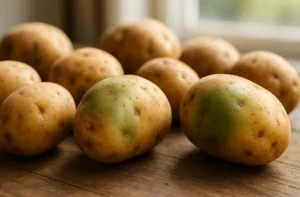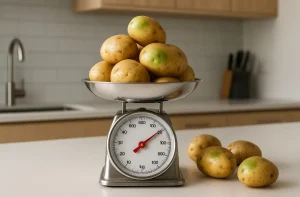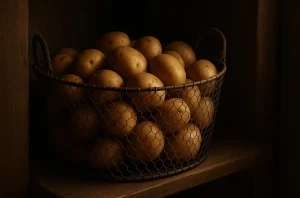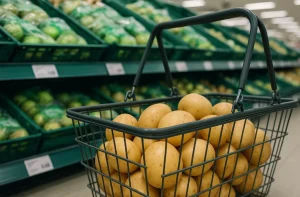Have you ever picked up a potato from the cupboard, noticed a green tinge under its skin, and wondered whether it was safe to eat? It may be tempting to cut away the discoloured part and carry on cooking, but the truth is that a green potato could be signalling something much more serious.
Potatoes that turn green are often linked to an increase in a natural toxin called solanine, which, when eaten in significant amounts, can lead to food poisoning and even neurological problems.
To understand the risks, it is important to look at why potatoes change colour, what solanine does to the body, and how to prevent it from becoming a problem in the kitchen.
Why Do Potatoes Turn Green?

The greening of potatoes is a natural process that occurs when the tuber is exposed to light. This could happen in the supermarket if the potatoes are displayed under bright lamps, or in the home when they are stored in an unsuitable place such as near a sunny window or on the kitchen counter.
When exposed to light, potatoes begin to produce chlorophyll, the same pigment that gives spinach and lettuce their characteristic green colour.
On its own, chlorophyll is completely harmless. It is present in many vegetables and is associated with health benefits rather than risks.
However, in potatoes, the presence of chlorophyll is a warning sign. Light exposure that encourages chlorophyll formation also stimulates the production of glycoalkaloids, mainly solanine and chaconine.
These compounds are produced by the potato as a natural defence mechanism against insects, bacteria, and grazing animals. Unfortunately, while they are effective for the plant’s survival, they can be harmful to humans.
The greening process can be obvious in light-skinned varieties of potatoes, where the yellow or beige skin develops a noticeable green patch. In darker-skinned potatoes such as reds or purples, the green pigment can be masked, and the only way to check may be to scratch away the surface to reveal the underlying colour.
Why Does the Green Colour Matter?
The green colour in a potato is not dangerous in itself, since it comes from chlorophyll. The real problem lies in what the green colour usually represents: higher levels of solanine. While chlorophyll and solanine are produced independently, the same conditions that trigger one usually stimulate the other.
This is why food safety experts recommend treating green potatoes with caution. The green skin signals that the potato has likely been exposed to conditions that increase solanine content. A potato with only a tiny green patch may still be safe once the area is cut away, but a potato that is extensively green is best thrown out.
In addition to colour, taste provides another important warning. Solanine has a distinct bitter flavour. If a potato tastes unusually bitter or leaves a burning sensation in the mouth or throat, it is an indication that glycoalkaloid levels are too high for it to be safely consumed.
What Is Solanine and How Does It Affect Humans?
Solanine is a naturally occurring chemical compound classified as a glycoalkaloid. It is most concentrated in the potato’s skin and around the sprouts or “eyes”, although it can spread into the flesh as well. The plant produces it to deter pests and pathogens, but in humans it acts as a neurotoxin.
When consumed in large enough quantities, solanine interferes with the nervous system. It disrupts the breakdown of acetylcholine, a neurotransmitter responsible for passing signals between nerve cells. This disruption can affect muscle control, digestive processes, and overall coordination.
The symptoms of solanine poisoning range from mild digestive upset to serious neurological effects. At lower doses, people may experience nausea, stomach cramps, diarrhoea, or headaches.
At higher levels, the toxin can cause confusion, hallucinations, fever, and in extreme cases, paralysis. While death from potato poisoning is very rare in modern times, it has been reported in history when people consumed large quantities of heavily green or sprouted potatoes.
How Much Solanine Is Too Much?

The level of solanine considered dangerous varies depending on body weight and the concentration in the potato. Research suggests that symptoms of poisoning may appear if a person ingests 1 mg of solanine per kilogram of body weight.
For a child, this could mean that just one medium-sized green potato is enough to cause illness, while an adult would usually need to consume several.
Food regulators set limits to keep potatoes safe for sale. In the European Union, the maximum acceptable level of glycoalkaloids in potatoes is 100 mg per kilogram of tuber weight, while in the United States and Canada, the limit is slightly higher at around 200–250 mg per kilogram.
Most commercially available potatoes fall well below these limits. However, when potatoes are stored improperly exposed to light, warmth, or physical damage, the solanine levels can increase significantly.
Table: Solanine Safety Guidelines
| Region | Maximum Allowed Glycoalkaloids in Potatoes |
| European Union | 100 mg/kg |
| United States | 200–250 mg/kg |
| Canada | 200 mg/kg |
Although these safeguards exist, responsibility also lies with consumers. Once potatoes leave the farm and enter a home kitchen, how they are stored and used makes a crucial difference to their safety.
Are Green Potatoes Always Harmful to Humans?
Not every green potato will make a person ill. The level of risk depends on how much solanine is present, which in turn depends on factors such as storage conditions, variety, and how the potato is prepared.
Peeling the skin and trimming away sprouts can reduce solanine content considerably, by up to 75 per cent in some cases.
Cooking can reduce the levels further, although it never eliminates them entirely. Importantly, boiling or baking at normal household temperatures does not destroy solanine completely, since it is relatively heat-stable.
Deep frying at very high temperatures may reduce it somewhat, but again not enough to render unsafe potatoes edible.
The safest guideline is this: if a potato has extensive greening or tastes bitter, it should not be eaten. In contrast, a potato with a small green patch that has been peeled and trimmed may be safe for consumption, though caution is advised.
How Can Green Potatoes Be Prevented?

The key to avoiding solanine poisoning lies in prevention. Potatoes that are properly stored rarely develop harmful levels of toxins. The most important step is to keep them away from light.
Exposure to light is the main trigger for chlorophyll and solanine production, so potatoes should be stored in a dark place such as a cupboard, drawer, or cellar.
Temperature also plays a role. Potatoes keep best at cool but not freezing conditions, ideally between 6–10°C. Refrigeration is not recommended, since it can cause the starch in the potatoes to convert into sugars, leading to a sweeter taste and, in some cases, promoting solanine formation.
On the other hand, leaving potatoes in a warm kitchen encourages faster sprouting and greening.
Physical damage can also stimulate solanine production. Potatoes that are bruised, cut, or cracked during handling are more likely to turn green and develop higher toxin levels. When shopping, it is wise to choose firm, unblemished potatoes, and to discard any that appear damaged at home.
What Should You Do If You Eat Green Potatoes?
Accidentally eating a small amount of green potato is unlikely to cause serious harm for most healthy adults, but it can still lead to unpleasant symptoms such as stomach upset or nausea. If symptoms are mild, they generally resolve within 24 to 48 hours without the need for medical intervention.
However, if someone develops more serious symptoms such as confusion, breathing difficulty, or paralysis, urgent medical attention is required. In the United Kingdom, advice can be obtained through NHS 111, a GP, or emergency services in severe cases.
Vulnerable groups, including young children, pregnant women, and the elderly, may be at greater risk and should seek advice more promptly if they feel unwell after eating potatoes.
Are Green Potatoes Still a Concern Today?

Although solanine poisoning is uncommon today thanks to strict safety regulations and widespread awareness, the risk has not disappeared.
Farmers and distributors monitor potato varieties carefully, and any that are known to produce high solanine levels are withdrawn from the market. Nonetheless, once potatoes are brought into the home, improper storage can still lead to greening and increased toxin levels.
Most cases of solanine exposure reported today involve individuals eating home-stored potatoes that had been left too long in unsuitable conditions. While severe outcomes are rare, even moderate symptoms of poisoning can cause significant discomfort.
Conclusion – Should Green Potatoes Be Eaten?
Green potatoes may look harmless, but they should always be treated with caution. The green colour itself is only chlorophyll, but it indicates that the potato has likely increased its production of solanine, a natural toxin that can make people ill.
While small green patches can sometimes be cut away, any potato that is extensively green, bitter to the taste, or heavily sprouted should not be eaten.
The best way to avoid problems is through prevention: store potatoes in a cool, dark, and dry place, handle them carefully to avoid damage, and always check them before cooking. In this way, it is possible to enjoy one of the UK’s most popular staple foods without unnecessary risk.
FAQs About Green Potatoes
Can peeling a potato remove all the solanine?
Peeling removes most solanine since it is concentrated in the skin, but it does not remove all of it. If the greening is extensive, the potato should be discarded.
Do darker-skinned potatoes turn green as well?
Yes, although the green pigment can be masked by darker colours. Scraping the skin can reveal whether greening has occurred beneath the surface.
Is it safe to eat sprouted potatoes?
Sprouted potatoes often contain higher concentrations of solanine in the sprouts and surrounding flesh. If sprouting is extensive, the potato is best thrown away.
Does cooking destroy solanine?
No, cooking methods such as boiling, baking, or frying reduce solanine slightly but do not eliminate it entirely.
How much solanine would cause poisoning in humans?
Toxic effects may appear at 1 mg per kilogram of body weight. For a child, this could mean illness from a single medium-sized green potato.
Why do some potatoes taste bitter even if they are not visibly green?
Bitterness is a reliable indicator of solanine, even when greening is not visible. Any potato that tastes bitter should not be eaten.
How can supermarkets keep potatoes safe?
By storing them in darkness, rotating stock regularly, and removing any that have visible greening or sprouting.
READ NEXT:






